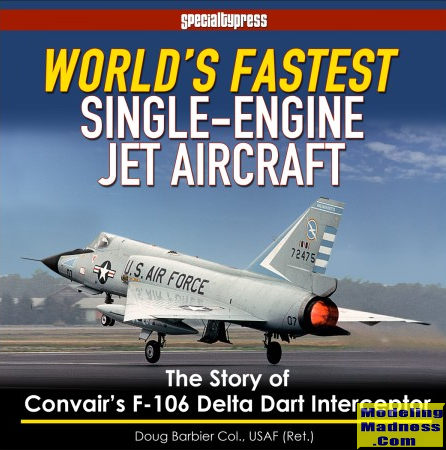
| PRICE: | $44.95 |
| PUBLISHER: | Specialty Pressoptions |
| REVIEWER: | Scott Van Aken |
| NOTES: | 228 pages, hardbound, over 350 images, ISBN 978-1-58007-237-3 |

For those of you who have not already guessed, this
is the story of the F-106 Delta Dart. During the 1950's, the paramount task of
the USAF's air defense command was to intercept and destroy Soviet bombers. To
that task, a rather bewildering number of aircraft were developed to perform
that particular task.
Probably the biggest drawback to these aircraft was their electronics.
Air intercept radar during those days was a growing specialty, and while these
early sets did work to some degree or another, they were frequently prone to
failure, something that was not unexpected. What was really needed was a state
of the art system attached to the fastest airframe around.
Convair had been working on the F-102 Delta Dagger, a plane that was
optimized for the interceptor role, It was basically rocket and missile armed,
as were just about all the current types. However, something better was needed.
This began the development of the F-102C.
There were several improvements in this plane over the standard F-102A.
One was the ability to carry a nuclear missile (the Genie) as well as four super
Falcons. Actually, the USAF waffled a great amount over the weapons load and
this caused not only delays, but frustration for the designers and engineers.
Secondly, it needed a more powerful engine than the J-57 that powered the F-102.
The result of this was the J-75. It was this engine that gave the new jet its
Mach 2+ performance. There were also airframe changes like the deletion of the
wing fences, the change in the shape of the intakes and a canopy with fewer
frames. Finally, the new plane was to be fitted with the Huges MA-1 system. This
was the first digital aircraft system that integrated all of the various
aircraft and ground inputs into one. Its development also seriously delayed the
full operational use of the F-106 as many airframes were delivered with ballast
where the MA-1 system was to be installed.
So different was the F-102C that soon after the first of a rather large
number of prototyp/pre-production planes were built, its designation was changed
to F-106. Once all the teething troubles had been worked out, and despite being
built in smaller numbers than hoped, the 106 soon proved its worth, being the
main equipment in several ADC units. The aircraft was turned over to some ANG
units, though these squadrons were operated in addition to some regular USAF
units. During its life span, there were improvements made to both the airframe
and equipment. A gun was installed in the 1970s and the main instrument panel
redesigned even before that along with other improvements. Like many USAF
fighters and interceptors, the 106 ended its days being converted into drone
targets.
This book is typical of Specalty Press' offerings in that it is superbly
written, equally well researched and contains a ton of interesting information
and stories. Not only the development of the aircraft is covered, but so are all
of the squadrons that used it as well as the changes in markings carried by the
aircraft.
It is a superb read and I book that I have no trouble giving my highest
recommendation.
May 2017 Copyright ModelingMadness.com.
All rights reserved. Thanks to www.specialtypress.com for the review
book. You can get this one direct
from this link. If you would like your product reviewed fairly and fairly quickly, please
contact
the editor or see other details in the
Note to
Contributors.
Back to the Main Page
Back to the Review
Index Page
Back to the Previews Index Page